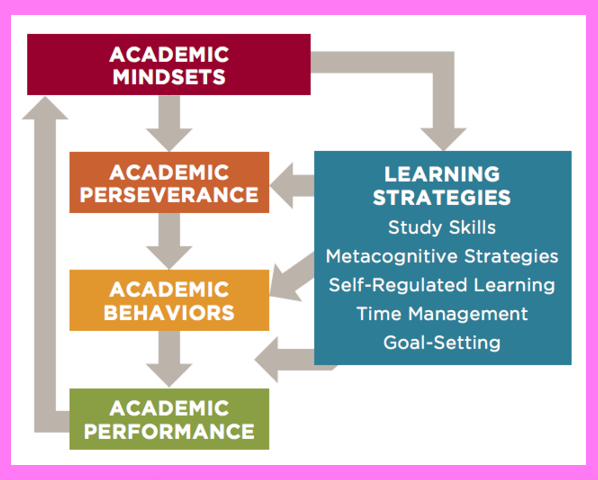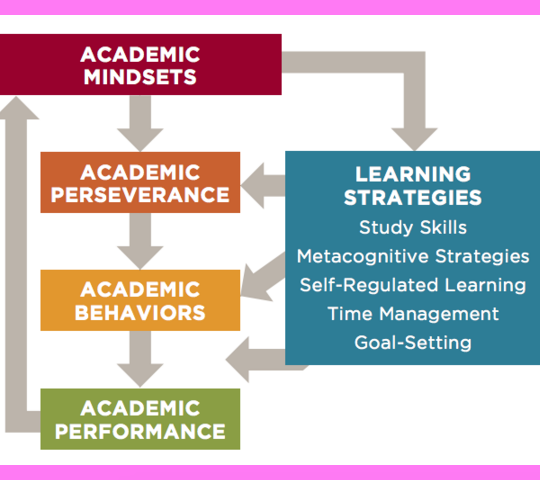


LEARNING STRATEGIES
- Involve several processes:
- metacognition:
- knowing how to monitor one’s misunderstanding
- self-regulated learning:
- intentional use of metacognition to learn
- selecting strategies and environments most conducive to learning
- selecting effective strategies can become automatic as students become more expert in specific disciplines
- monitoring learning processes to adjust effort to meet demands of those processes
- fighting urge to give up on learning processes
- multiple phases of self regulation:
- judging one’s cognitive abilities (judgment of learning or JOL)
- seeing connections between current tasks and prior knowledge
- assessing difficulty of tasks
- using knowledge of what one knows and needs-to-know to apply more or less effort as needed
- common pitfall – stopping effort too soon before knowledge is obtained
- assessing factors related to academic tasks and how they impact one’s learning
- setting goals and planning to meet these
- deciding on standards that will determine success of efforts
- selecting cognitive strategies that improve performance
- changing strategies (if needed) to learn better
- major reconfiguration of student’s approach to future tasks based on experience
- happens rarely
- judging one’s cognitive abilities (judgment of learning or JOL)
- multiple phases are iterative in nature
- types of self regulation processes:
- Cognitive strategies:
- practicing, rehearsal
- organization and elaboration
- organizing and elaborating on information is more effective than just remembering information
- deep processing: applying study tactics such as
- finding relationships between old and new material,
- rearranging knowledge into meaningful structures (schematic)
- Metacognitive strategies:
- self-evaluations
- goal setting and monitoring
- Resource-oriented strategies:
- information seeking
- record keeping
- seeking social assistance
- creating favorable learning environments
- Cognitive strategies:
- goal setting
- setting and regulating monitoring progress towards goals
- changing approaches to better reach goals
- metacognition:
- Possible effects of learning strategies:
- increase productivity of academic behaviors -> better academic performance
- better academic performance -> better sense of self efficacy
- better self efficacy -> more academic perseverance
- better academic performance -> enhanced academic mindsets
- Possible causes of learning strategies:
- students with academic mindsets are more likely to use learning strategies
- Possible effects of LACK OF of learning strategies:
- poor academic behaviors -> poor academic performance
- students are less likely to complete homework or study for tests when they lack strategies to do these tasks effectively
- poor grades -> poor academic mindsets -> lessen academic perseverance
- Possible causes of POOR learning strategies:
- poor academic mindsets -> less likely to use learning strategies
RELATIONSHIP BETWEEN LEARNING STRATEGIES AND ACADEMIC PERFORMANCE:
- Students who use self regulation strategies tend to perform better in learning activities / tasks.
- Students with high self efficacy tend to use metacognition and self regulation strategies more.
- Self regulation is a strong predictor of academic achievement.
- Students who perceive learning as understanding (not memorizing) tend to use more strategies to learn.
ARE LEARNING STRATEGIES MALLEABLE?
- Metacognitive strategies can be learned.
- Effective metacognitive strategies that can be taught:
- awareness of textual inconsistency
- self questioning to monitor and develop comprehension and to make one aware of problem solving steps
- Use of several metacognitive strategies improved reading comprehension
- Metacognitive strategies assist with learning at higher thinking levels
- Teaching learnings strategies in context of a course makes better than teaching them in isolation
- Transfer of learning strategies to new subjects requires:
- basis of how strategy works
- when / where strategy works
- what it requires of learner
- the farther the transfer, the more conditional knowledge is needed
- Math cues that increased metacognition:
- what is the problem about?
- what steps would you use to solve this problem
- these cues helped students draw on prior knowledge, identify problem structures, and evaluate effectiveness of problem solving processes
- Bootstrapping approach to developing learning strategies:
- students learn strategies through trial and error or by observing others
- bootstrapping occurs more in students with academic mindsets
- Limitation of research = based on self reporting of use of strategies
ROLE OF CLASSROOMS & DEVELOPMENT OF LEARNING STRATEGIES
- Ways to improve learning
- paying attention to their thinking as they read, write and problem solve
- Learning strategies tend to be subject-specific -> content-area classrooms are key places to learn strategies
- Classroom environments that foster academic mindsets make it more likely for students to apply learning strategies (not enough to simply teach strategies – need mindsets too)
CLASSROOM STRATEGIES THAT PROMOTE LEARNING STRATEGIES:
- Timely ongoing feedback helps students monitor the effectiveness of their approaches to learning.
- Self assessments of performance helps students practice metacognitive strategies of self-reflection and critique of learning.
- Teach subject-specific metacognitive strategies. See math cues above as examples.
- Transfer of subject-specific strategies is more likely to occur when strategies are taught in context of a specific subject.
- Reading specific metacognitive strategies that can be taught
- recognizing when one doesn’t understand reading
- using strategies to redirect and refocus comprehension such as
- rereading,
- back and forth search strategies,
- self questioning – comparing text to prior knowledge
- comparing main ideas of text with details of text
- Strategies that can be taught:
- students talk about their thinking as they plan their approach to an academic task
- paired problem solving – one students explains how they will solve problem while another listens and asks clarifying questions
- reciprocal teaching – dialog between teacher and students that involves text summaries, question generation, clarifications, and predictions of what till happen next
- Thinker Tools Inquiry Curriculum
- Physics curriculum that has students compare virtual experiments to experiments performed on actual objects
- Encourages metacognition by having students reflect on their own processes of investigation
- students can learn to identify challenges to academic behaviors and apply appropriate strategies to move forward
- self regulation strategies that can be taught:
- mental contrasting – comparing one’s vision for desired future with existing constraints / obstacles that can impede goals
- implementation intentions – identifying steps to reach one’s goals written in the form of if statements – if this happens, then I will do this …
- Applying two strategies above can increase academic perseverance
- literacy techniques:
- previewing reading passages
- restating main ideas in one’s own words
- test taking strategies:
- using note cards to quiz themselves
- making up test questions
- playing review games
- goal setting strategies
- setting aside regular time to set and monitor progress towards goals
- students talk about their thinking as they plan their approach to an academic task
CAN LEARNING STRATEGIES CLOSE ACHIEVEMENT GAPS?
- Very few research studies were designed to investigate gender and race related effects
- Lack of research is not a proof that this can work
RESEARCH SUMMARY
- Learning strategies make academic behaviors more effective and more likely -> deeper learning and higher achievement
- Students with academic mindsets are more likely to apply learning strategies.
- Classrooms serve 2 key purposes – teach learning strategies and promote academic mindsets

Teaching learning strategies can encourage students to pursue more effective academic behaviors long enough that they can help students learn. Teaching subject-specific learning strategies helps students learn content. Teaching students the underlying hows / whys / whens of specific learning strategies makes them more able to transfer those skills to other disciplines

Preparation Steps
- Analyze course and determine subject-specific learning strategies that are key to the success of students in the course
- Research learning strategies. See related articles below.
- Select scaffolding activities that support key learning strategies for course.
- Create classroom culture that promotes Academic mindsets
Early Implementation Steps
- Implement scaffolding of learning strategies in the contexts where they are most useful.
- Ask students to reflect on how learning strategies are affecting their learning.
- Use student reflections to fine tune scaffolding of learning strategies.
Advanced Implementation Steps
- Use observations and student feedback on learning strategies to learn which strategies to incorporate into classroom routines.
- Collect student stories of using learning strategies to overcome challenges in order to inspire future students

- Taxonomy of Thinking
- Alternate question response formats
- Teaching students how to generate questions
- Emotional Self-Control Tools and Strategies
- Activating prior knowledge
- Nonlinguistic representations
- Summarizing & note taking
- Writing to learn strategies (1 of 2)
- Writing to learn strategies (2 of 2)
- Checks for understanding
- Engaging students with data
- Lesson plan model for cognitive engagement
- Academic mindsets
- 5 academic performance factors
